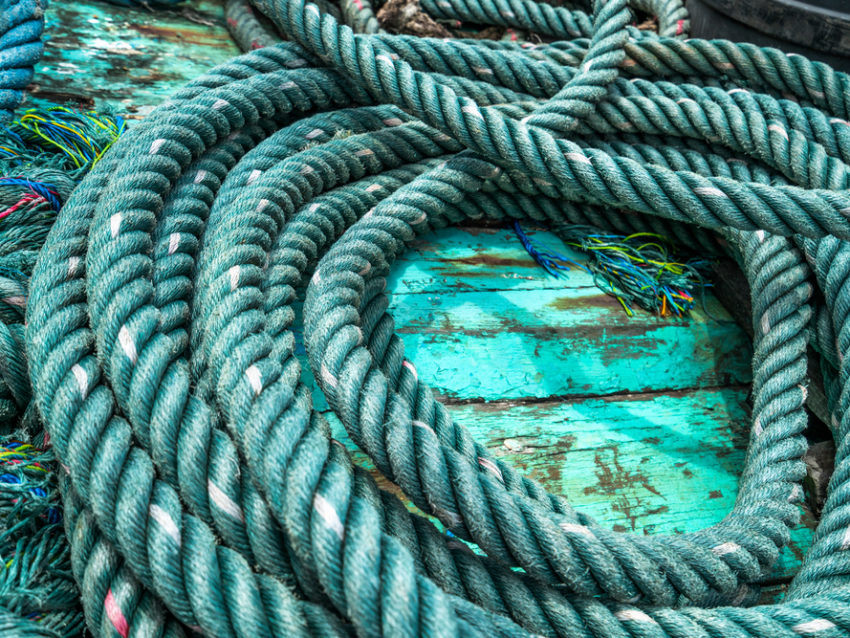
How to Select Rope
- Rope Construction
- Rope Fibers and Types
- Extend the Life of Your Rope
Rope Construction:

SOLID BRAID: A firm, round rope that works extremely well on blocks and pulleys. Its name refers to the special lock-stitch construction of the rope. Solid Braid rope does not unravel as much as other construction when cut or accidentally broken,. It is available in various synthetic and cotton fibers

HOLLOW BRAID: This rope is constructed of 8,12, or 16 strands with a hollow center. An outstanding characteristic of this construction is its ability to be quickly spliced. It is available in various synthetic fibers.

DOUBLE BRAID: Two braided ropes combined into one rope. A braided core is covered with a braided jacket to produce a strong, handsome, easy handling rope. This rope can be spliced and, in most instances, is stronger than twisted rope of the same material and diameter. It is available in various synthetic fibers.

DIAMOND BRAID: Constructed with a tighter locking interlacing of yarns, normally using 8 or 16 strands. This construction permits an inner core that is used for the purpose of adding strength or a filler to produce a larger rope diameter.

TWISTED: Also known as Laid Rope. Just about all laid rope is 3-strand construction. It may be spliced and is available in virtually every type of rope fiber. This is the most common rope construction for general purpose use.

PLAIT: A rope where four sets, of two strands each, are intertwined in a maypole fashion around the rope axis in a plain pattern, one over and one under.
Rope Fibers & Types:
COTTON: Cotton is hard to beat for handling quality,. It is soft and pliable, and easy on the hands. Since it is a natural fiber, it does not have the strength or durability of synthetic fiber ropes. It is used for sash cord, clothesline, and Venetian blind cord.
MANILA: Manila is made from natural fibers. At one time, it was the best rope fiber available. Manila must be handled and stored with care as dampness will cause it to rot.
NYLON: Nylon is a synthetic fiber rope. Due to its elasticity, nylon can absorb sudden shock loads that would break ropes of other fibers. It has very good resistance to abrasion and will last four to five times longer than natural fiber ropes. Nylon rope does not rot and is not damaged by oils, gasoline, grease, marine growth or most chemicals other than acids.
POLYESTER: A very strong synthetic rope with excellent abrasion resistance. Polyester does not have the stretch and elasticity of nylon. Polyester is superior to nylon with respect to cycle loading and abrasion.
POLYETHYLENE: A floating rope somewhat like polypropylene but slightly heavier. Polyethylene’s handling characteristics are a little different than polypropylene. Not quite as strong as Polypropylene size for size, but has better abrasion resistance. Available in twisted and hollow braid construction.
POLYPROPYLENE (Poly): Lightweight and strong. It is a floating rope and is rot proof and unaffected by water, oil, gasoline, and most chemicals. Polypropylene rope is available in monofilament fiber, which is smooth surfaced, or multifilament fiber, which has a somewhat velvety appearance and feel.
UNMANILA®: Unmanila is constructed from polypropylene fiber with the rich, golden tan color of manila rope. The surface of the rope has the texture of manila with soft hair-like fibers. It holds a knot extremely well and provides an excellent gripping surface to minimize slippage. It has all the advantages of the modern synthetics, plus the rope color that many people like. It is rot proof, water proof and not damaged by oil, gasoline or most chemicals. In addition, it floats on the surface of water.
Extend the Life of Your Rope:
- Use the correct rope for your purpose.
- Don’t overload your rope.
- Protect your rope with chafing gear.
- Avoid sudden shock loads.
- Keep the kinks out.
- Avoid sharp angles.
- Use the correct size rope on sheaves and pulleys.
- Reverse the ends from time to time.
- Keep your rope free of chemicals.
- Keep it clean.
- Store rope properly.
